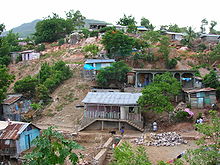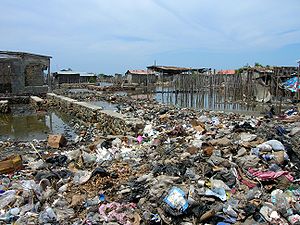
Poverty in Haiti
Encyclopedia

Gross domestic product
Gross domestic product refers to the market value of all final goods and services produced within a country in a given period. GDP per capita is often considered an indicator of a country's standard of living....
(GDP) estimate of US$6.56 billion in 2009, Haiti
Haiti
Haiti , officially the Republic of Haiti , is a Caribbean country. It occupies the western, smaller portion of the island of Hispaniola, in the Greater Antillean archipelago, which it shares with the Dominican Republic. Ayiti was the indigenous Taíno or Amerindian name for the island...
is routinely regarded as one of the poorest nations in the western hemisphere. Based on estimates by the World Bank
World Bank
The World Bank is an international financial institution that provides loans to developing countries for capital programmes.The World Bank's official goal is the reduction of poverty...
in 2005, the percentage of people living below the US$1 per day poverty line in Haiti is 54%, and the percentage of people living below US$2 per day is at 78%.
Poverty

Port-au-Prince
Port-au-Prince is the capital and largest city of the Caribbean nation of Haiti. The city's population was 704,776 as of the 2003 census, and was officially estimated to have reached 897,859 in 2009....
in a bid to escape poverty in the more rural areas of the country.
Corruption
In 2009, Haiti was ranked the tenth most corrupt country in the world by Transparency InternationalTransparency International
Transparency International is a non-governmental organization that monitors and publicizes corporate and political corruption in international development. It publishes an annual Corruption Perceptions Index, a comparative listing of corruption worldwide...
's Corruption Perception Index, with a CPI score of 1.8. Studies conducted by Transparency International shows a strong correlation
Correlation
In statistics, dependence refers to any statistical relationship between two random variables or two sets of data. Correlation refers to any of a broad class of statistical relationships involving dependence....
between corruption and poverty. Corruption increases poverty through lower economic growth rates, biased tax systems which would also lead to a widening disparity between the rich and the poor, poor implementation of social programs, lower welfare spending and unequal access to education. Specifically for Haiti, studies have shown that international donors have been slow to assist Haiti, mainly due to widespread corruption and structural problems present in Haiti. Overseas charitable organisations have contributed more than 2.6 billion dollars’ worth of aid to the country since 1994, of which any obvious benefits have yet to seen.
Infant Mortality
The high Infant MortalityInfant mortality
Infant mortality is defined as the number of infant deaths per 1000 live births. Traditionally, the most common cause worldwide was dehydration from diarrhea. However, the spreading information about Oral Re-hydration Solution to mothers around the world has decreased the rate of children dying...
Rate of 64 deaths per 1000 live births is a result of the poor healthcare system, and the lack of a well-planned education system is the cause of low literacy rates (45%) in the country.
| Under 5 Mortality Rate: | Per 1,000 live births |
|---|---|
| 1990 | 152 |
| 2009 | 87 |
| Infant Mortality Rate (under 1): | Per 1,000 live births |
| 1990 | 105 |
| 2009 | 64 |
Inequality
Haiti ranks 59.5 in the Gini CoefficientGini coefficient
The Gini coefficient is a measure of statistical dispersion developed by the Italian statistician and sociologist Corrado Gini and published in his 1912 paper "Variability and Mutability" ....
index, with the richest 10% of Haitians receiving 47.83% of the nation's income, while the poorest 10% receive less than 0.9%.

